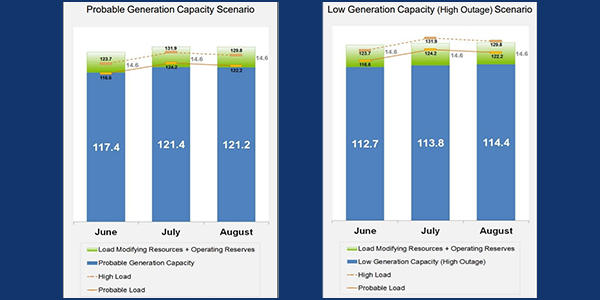A forecast for warmer-than-usual weather means MISO will likely have to declare an emergency this summer — even without heavy loads or a high volume of generation outages, the RTO said Tuesday.
The RTO is projecting a 125-GW summer peak and 152 GW of total capacity on hand to manage the load before generation outages are factored in.
“We expect higher load than usual … but we have adequate resources,” Executive Director of Energy Operations Rob Benbow said during a summer readiness conference call.
MISO’s all-time summer peak of 127 GW occurred July 20, 2011. MISO last year registered a 121-GW summer peak in mid-July, far short of the nearly 125-GW peak forecast. The RTO last year had 149 GW of available capacity to cover peak demand.
Benbow warned that challenges await if MISO experiences high load coupled with high outages in July or August, circumstances that would likely prompt it to declare an emergency and dip into load-modifying resources and operating reserves.
The National Oceanic and Atmospheric Administration forecasts “warmer-than-normal temperatures for a majority of the MISO footprint,” Resource Adequacy Coordination Engineer Eric Rodriguez said.
In a probable scenario, MISO will have about 117.4 GW worth of capacity for a 116.6-GW average load during June. July contains the most risk, with even a probable load of 124.2 GW eclipsing its 121.4 GW of available resources. In August, the RTO still runs the risk of tapping into its emergency stack, with a probable 122.2 GW of load exceeding its 121.2 GW worth of nonemergency resources.
MISO is all but certain to declare emergency procedures during all three months should it experience even lower available capacity than in a probable scenario. Benbow said it also is preparing for the possibility of hurricanes in MISO South.
“On top of that, we’ll run into challenges with COVID-19,” he said, adding that MISO expects to continue to encounter difficulties forecasting day-ahead load as lockdowns and social distancing measures persist into the summer.
The RTO expects forced generation outages this summer to exceed its five-year average but still remain below the summer of 2018, when outages neared 25 GW in all three months. Outages will hit about 23 GW in June, then hover around 15 GW in July and August, it said. A fraction of the increased generation outage activity in June can be put down to impacts from the coronavirus pandemic.
As of April 20, 19.5 GW of planned generation outages had been canceled or rescheduled as a result of the pandemic. About 1.1 GW of those outages are tentatively rescheduled for early June, but more generation owners are planning to reschedule in the fall.
MISO outage coordinator Trevor Hines said generation owners are rescheduling outages thoughtfully, with concern for summer conditions. He said the outage disruptions so far will not affect reliable operations.
The RTO has also seen 101 — or about 16% — of its planned transmission outages changed since the pandemic required utilities to separate personnel, limiting some maintenance activity. Half have been canceled altogether, with the other half to be spread out over May and June, Hines reported.
Continuity in Uncertainty
South Region Operations Director Tag Short said that as MISO moves into summer, it will focus on “business continuity” even as staff remain physically separated between control rooms in three different states and working from home.
Short said MISO will continue working with states “to gain access to test kits so our control room personnel can be tested in advance of shift changes.”
The RTO is already monitoring the body temperatures of control room staff and distributing face masks for employees that remain on-site. Its janitorial staff is also sanitizing facilities more often.
“We tried to reduce as many touch points as possible, and that’s not easy when they share a bathroom and a kitchen,” Short said of MISO’s control room staff.
Manager of Forecast Engineering Blagoy Borissov said load continues to track about 10% lower than normal since closures and lockdowns became the norm in MISO states. He added that morning and evening ramps remain flatter than usual.
Borrisov said MISO’s forecasting team had to “freeze” its forecasting model prior to the pandemic taking root in the footprint so the model wouldn’t make load shape adjustments or match the forecast to recent history, which is temporarily an unreliable benchmark.
“We are pretending that our load forecasting model has not been updated since March 13,” Borissov explained.
Borissov said an inevitable uptick in load will be difficult to anticipate as temperatures rise and states begin testing the relaxation of pandemic measures.
MISO will continue to restrict visitors to its facilities through at least June 1. Vice President of System Planning Jennifer Curran this week said it’s “too early” to tell when the RTO can return to normal operations.




